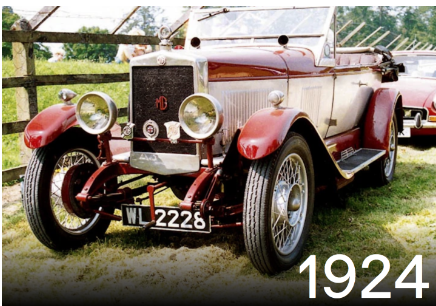The first MG car was designed by Cecil Kimber a whole century ago, back in 1924. But who was he? How did MG cars get started? And what led to the design of the very first MG car?
This article answers those questions and more, exploring the origins of MG and the factors that contributed to the design of its original model. We hope you enjoy this piece of classic car history.
Who Designed the First MG Car?
Cecil Kimber, the General Manager of Morris Garages (MG), designed the first MG car in 1924. Known as the MG 14/28, and later the MG 14/28 Super Sports, the first MG sports car was built on a Morris Oxford chassis with a special body and badge designed by Kimber.
Kimber’s vision for MG was to create affordable, high-performance sports cars that stood apart from those at Morris Motors, and his work quickly established MG as a reputable brand for accessible performance vehicles in the automotive world.
His pioneering designs laid the foundation for MG's rise to fame as a beloved sports car manufacturer.

Source: MG Motor
The Birth and History of MG Cars
In 1924, Morris Garages (MG) was established by British motoring pioneer William Morris, and first launched as a sportier division of Morris Motors. Salesman Cecil Kimber was promoted to General Manager of MG that same year, where he began to design special bodywork for the company’s original Morris cars.
Kimber is credited with designing the first official MG car (the 14/28) in 1924, which featured a new octagonal logo and was designed to be faster and sportier than Morris cars.
From 1924, a range of rebodied Morris and MG badged models were being sold as ‘Kimber Specials’ and an overflowing order book resulted with MG assembly taking place at the Alfred Lane works before moving to a larger premise in Barton Road.
Kimber would go on to design a number of original MG sports cars for the company.

Pictured: Morris Garages publicity photograph showing young works demonstrator, Jack Gardiner, in an early ‘M.G. 14/28 Super Sports’ of late 1924. Source: The SAHB.
MG’s Rise to Fame
MG Motor soared in popularity in the 1930s, with the company becoming one of the most famous brands of sports cars in the world. The company’s cars were known for their sleek designs, powerful engines, and agile handling.
However, MG’s success in the 1930s was driven not only by its stylish, high-performance sports cars but also by its growing reputation in the world of motorsport. The company’s commitment to racing helped it gain international recognition, with models like the MG K3 Magnette achieving impressive victories.
Notably, the K3 Magnette won its class at the 1933 Mille Miglia, one of the world’s most challenging endurance races, further solidifying MG’s status as a competitive force in automotive racing. In addition to racing success, MG continued to innovate with its vehicle designs, offering a range of models that appealed to both sports car enthusiasts and daily drivers.
The brand’s ability to balance performance, affordability, and style helped MG build a loyal customer base, making it one of the most recognisable names in British motoring by the end of the decade. MG's influence in the 1930s set the stage for its continued growth and dominance in the years that followed.
Notable Early MG Models
Some of the notable early designs from MG include:
- The MG 14/28: Designed by Cecil Kimber and first released in 1924, the MG 14/28 was the first MG marque, with a top speed of 65 mph.
- The Old Number One: Designed by Cecil Kimber and first released in 1925, the Old Number One aimed to be smaller, faster and more fun to drive than the original model.
- The MG Midget: One of the most iconic MG models, known for its sleek design and agile handling, the first MG Midget was introduced by MG in 1929.
- The MG Magnette: Another notable model, featuring a powerful engine and luxurious interior, the first MG Magnette was released in 1933.
- The MGA: The MGA was released in 1955 and featured a brand new 1498 cc engine amongst other notable features.
- The MGB: The MGB was launched by MG in 1962, and remained the best-selling MG for decades.
MG’s Legacy and Impact
MG has had a significant impact on the automotive industry, with its sports cars influencing the design of cars around the world. The company’s involvement in racing has also had a lasting impact, with MG cars continuing to compete in events such as the British Touring Car Championships in 2019.
The MG brand has become synonymous with British sports cars and is a coveted name by car enthusiasts around the world. The company’s legacy continues to inspire new generations of car enthusiasts and designers.
Closing Thoughts
Cecil Kimber's innovative design and vision for the MG brand laid the foundation for its enduring legacy in the automotive world. From its humble beginnings in 1924 to becoming a symbol of affordable performance, MG has captured the hearts of car enthusiasts for decades.
The brand's rich history in motorsport and commitment to quality and style continue to inspire new generations of drivers. As MG evolves, its legacy as a pioneer of accessible sports cars remains a testament to Kimber’s groundbreaking design work.
For those looking to restore or enhance their classic MG vehicles, MGOC Spares offers a wide range of authentic Classic MG Parts and Accessories to keep your MG running smoothly and looking great.
Whether you need replacement components or performance upgrades, our extensive inventory caters to all your MG needs.
Explore our MG parts catalogue and continue the legacy of your MG today!